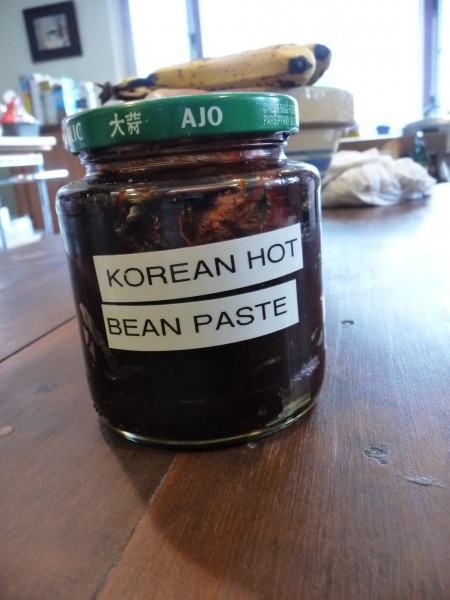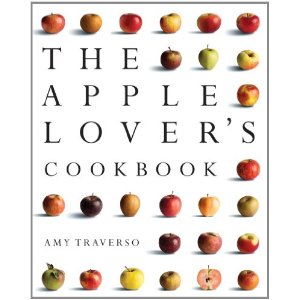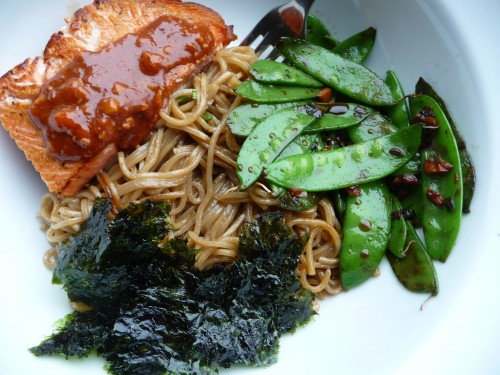 I’m going through a new lunch phase at the moment, that can only be described as an Asian-Korean Influenced-Everything-but-the-Kitchen-Sink-Noodle-Bowl Phase. Since I work from home, I’m in charge of my own feeding during the day, which means I can’t just stroll to a neighborhood lunch spot like I used to do when I toiled in midtown Manhattan, and pick up a $20 mixed green salad. Although I do miss grabbing a roti or chicken-over-rice from my favorite food carts on 6th Avenue, I’m undoubtedly saving a fortune by making my meals at home (and it really would have been a shame to spend all of Belle and Conor’s college tuition on overpriced salads).
I’m going through a new lunch phase at the moment, that can only be described as an Asian-Korean Influenced-Everything-but-the-Kitchen-Sink-Noodle-Bowl Phase. Since I work from home, I’m in charge of my own feeding during the day, which means I can’t just stroll to a neighborhood lunch spot like I used to do when I toiled in midtown Manhattan, and pick up a $20 mixed green salad. Although I do miss grabbing a roti or chicken-over-rice from my favorite food carts on 6th Avenue, I’m undoubtedly saving a fortune by making my meals at home (and it really would have been a shame to spend all of Belle and Conor’s college tuition on overpriced salads).
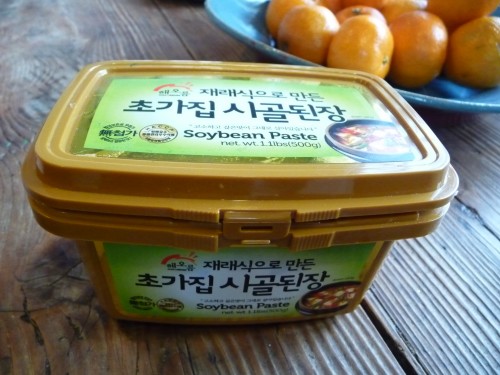
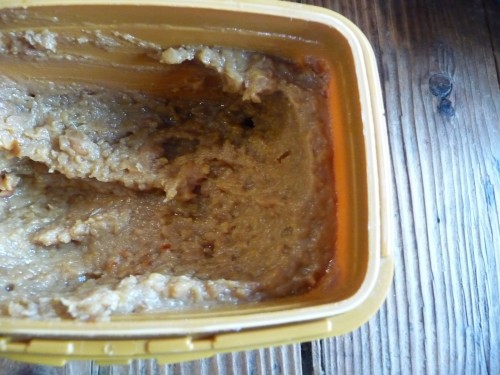 Two key ingredients that have facilitated this new phase are above: Korean hot bean paste (it doesn’t normally come in a jar with a LabelMakerPro label, my friend and Korean-food guru Sujin decanted some from her private stash) and Korean miso. Now I’ve always just relied upon the Japanese-style white or yellow miso that you find at Whole Foods, which is fine, but the Korean miso (which I found at H Mart, an Asian grocery store which also has mail order, see HERE) is the boss of that other stuff. More flavorful and beautifully textured, I am in love with it. Stirred into broth for soup, added to sauces, added to marinades for meat or chicken, or in the case of the lunchtime noodle bowl, used as the base for an amazing condiment inspired by the one served at a Korean BBQ restaurant (see the sauce on the salmon in the picture up top). Here’s what I do:
Two key ingredients that have facilitated this new phase are above: Korean hot bean paste (it doesn’t normally come in a jar with a LabelMakerPro label, my friend and Korean-food guru Sujin decanted some from her private stash) and Korean miso. Now I’ve always just relied upon the Japanese-style white or yellow miso that you find at Whole Foods, which is fine, but the Korean miso (which I found at H Mart, an Asian grocery store which also has mail order, see HERE) is the boss of that other stuff. More flavorful and beautifully textured, I am in love with it. Stirred into broth for soup, added to sauces, added to marinades for meat or chicken, or in the case of the lunchtime noodle bowl, used as the base for an amazing condiment inspired by the one served at a Korean BBQ restaurant (see the sauce on the salmon in the picture up top). Here’s what I do:
Korean Miso and Bean Paste Condiment
Mix some yellow Korean miso (the one I have has some small pieces of soy bean still in it, you can smash them up with your spoon or just leave it) with a smaller spoonful of the bean paste (per your taste, it is not super hot but start with a little and work from there), enough lime juice or rice vinegar to loosen the combination up a bit, and a squirt of honey or agave. Combine and taste. Add more of whatever you think it needs. If you want it to be even more decadent, add a spoonful of Hellman’s mayo. I keep a jar of this in the fridge and use the batch throughout the week.
Besides it usefulness as a vehicle for delicious condiments, noodle bowls are also a useful way to use up the many odds and ends in my fridge from cookbook testing. Ingredients I’ve thrown together include: pork meatballs spiked with ginger and scallions, leftover ginger-scallion sauce, torn sheets of roasted seaweed, shredded carrots, sauteed greens like pea pods or bok choy, shredded raw brussels sprouts, kale, avocado, soft-boiled eggs, kimchi, leftover pieces of rotisserie chicken or salmon, seared tofu, diced ham, lettuce…
For the noodles I’ve been thrilled to now find organic soba and udon noodles at my local supermarket. If you don’t see them in the Asian-food aisle, then ask the manager to stock them! You can also use ramen noodles (without using the flavor packet it comes with) or rice sticks (like the kind used for pad thai). At the Korean supermarket I bought some fresh buckwheat noodles (see top photo), which are delicious and cook in 4 minutes, if you can find them. Once you cook any of these noodles, rinse them in cold water and then warm them in a pan. Sometimes I will stir-fry some vegetables first with ginger and garlic, and then add the noodles with soy sauce and sesame oil.
For those of you who work out of the home, then you can also bring them to work for lunch. Cook your noodles the night before and then in the morning reach into the fridge and just layer everything in your lunch container: sauce/condiment/dressing on the bottom, then noodles, then vegetables or protein. Shake it all up right before eating. ENJOY!

